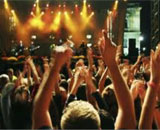 Fill a venue with thousands of charged-up fans, bring in their favorite band, pump up the volume, add some alcohol and crack-heads, and watch how things explode. Musical concerts are notorious for causing bizarre accidents, which sometimes lead to loss of lives and serious injuries.
Fill a venue with thousands of charged-up fans, bring in their favorite band, pump up the volume, add some alcohol and crack-heads, and watch how things explode. Musical concerts are notorious for causing bizarre accidents, which sometimes lead to loss of lives and serious injuries.
Take the 2010 Pearl Jam performance at the Roskilde Music Festival in Denmark, for instance, where some 50,000 spectators showed up. The rear rows could not hear their idols grunge, so they started pressing forward. Before anyone knew it, gigantic human waves had already become unstoppable, and eventually crushed 11 people to death. The unfortunate accident wasn’t the worst of its kind, as some other music venues have caused hundreds of casualties in a single night.
It is not a surprise, then, that the government takes health and safety at musical concerts very seriously and strictly holds the organizers and the management accountable for any untoward incidents taking place during such events. Only serious consideration of all safety precautions and meticulous planning can save people's lives, including your own. Here are some vital health and safety consideration that you should pay attention to when planning and executing a musical event.
Before the Concert
Alright, so you've booked the venue and the sound system as well as the artists; health and safety must be at the top of your mind now. Never let commercial gain make you compromise on safety. Most of the concert accidents happen because of over-crowding, which is the result of over-selling the capacity of the venue. If you think too many people would show up uninvited, make security arrangements and prepare contingency plans to deal with such a situation.
Identify all such equipment, activities, and situations that can cause health and safety hazards. For instance, make sure that no live wires are scattered on the floor around the stage or near the entrances. If you're making a temporary stage, validate its strength and integrity under maximum load. Spectators' enclosures and railings should also be inspected similarly.
Falling , suffocation risks (due to lack of ventilation or over-crowding), unruly spectators, tripping hazards (which can usually be sorted with cable protectors), fire and fireworks hazards, and all others risky areas and activities involved must be considered and written down in the form of a separate risk assessment report for each hazard. This paperwork will help you coordinate health and safety with your team, and would also save your neck if something unfortunate happens at the concert.
The entry and exit routes must be clearly identified and should be spacious enough to accommodate the flow of the expected crowd. Some of the worst concert accidents have happened because of the lack of exits during a fire or a stampede.
You should make an elaborate plan, including the roles and responsibilities of all team members. Appoint an event manager and a health and safety officer and give them the requisite crews for fulfilling their responsibilities, which must be clearly spelled out. Establish a communication network to help the team communicate with one another instantly.
During the Event
When the big day arrives, you'll be a confident person if you've paid proper attention to planning, particularly to health and safety. However, don’t let this confidence get the better of you. As described earlier, the conditions at a musical concert are ripe for accidents, and the unexpected can strike any time.
It is important to stay on guard throughout the concert and watch out for all the hazards that you have assessed, plus anything else that you might notice on the ground. The number of people, the security arrangements, the entry/exit routes, the electrical equipment and connections, the stage and the spectator stands, the mood of the crowd—everything needs to be monitored, by you and each member of your team.
You must have your contingency plans ready, the plans that spell out the actions in case any of the major expected emergencies transpires. The steps to be taken in case of fire, injury, stampede, suffocation, etc must be briefed to and understood by all the crew members. Fire extinguishers, first-aid kits, and other safety equipment deemed necessary must be kept within easy access of people and in the vicinity of the hazard points. The contact numbers of the fire department, police station, and hospital should be available with all crew members, just in case.
So, now you are a bit more aware of the importance of planning and implementing safety for a musical concert, but this article is by no means the last word on the subject. You can take help from the HSE resources and the city council's recommendations for further, more elaborate guidance.
The Workplace Depot provides has one of the largest ranges of indoor and outdoor cable protectors, ideal for musical events and festivals - click here for details.
Posted in Expert Commentary